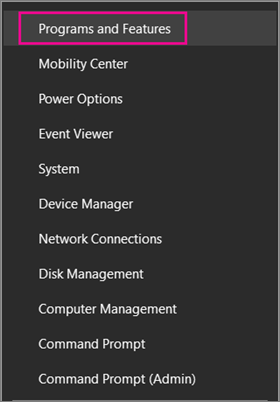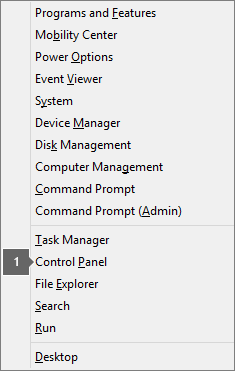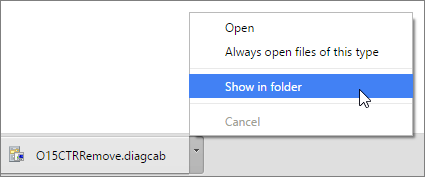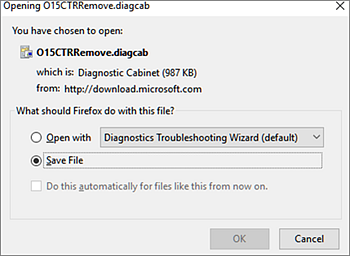Error code 30033 when installing Office
If you get an error that contains 30033 when you try to install Office. here are some things you can try to fix the problem. We've listed the most common solutions first, so try them in order.
Tip: Sometimes restarting your computer is enough to fix the problem.
1 - Use the offline installer to install Office
The Office offline installer may help bypass potential proxy, firewall, antivirus, or Internet connection issues that might occur during an Office 2016 installation.
How you use the offline installer depends on which Office product you have. See Office for home and Office for business plans and then select from the table below.
| Office product | Do this |
|---|---|
| Your Office product is under Office for home | |
| Your Office product is under Office for business | Contact your admin. If you're the admin, you can Contact Office 365 for business support for help. Admins can also use the Office Deployment Tool to download the Office software to your local network. You can then deploy Office by using the software deployment method you typically use. |
2 - Repair Office from the Control Panel
The steps to access the repair tool vary depending on your operating system. Choose your operating system from the options below.
Windows 10
-
Right-click the Start button
 (lower-left corner), and select Programs and Features on the pop-up menu.
(lower-left corner), and select Programs and Features on the pop-up menu.
-
Right-click the Microsoft Office product you want to repair, and select Change.
Note: If you have a suite such as Office 365 Home or Office Home and Student 2013 or 2016, search for the suite name, even if it's just a particular application you want to repair such as Word or Excel. If you have a standalone application such as Word or Excel, search for the application name.
-
From the "How would you like to repair your Office Programs" screen, select Online Repair to make sure everything gets fixed, and then select Repair. The Quick Repair option is also available, which runs faster but only detects and then replaces corrupted files.
Note: If your copy of Office is MSI-based, select Repair and then click Continue. If you need help figuring out if your Office is Click-to-Run or MSI-based, see below.
-
Follow the instructions on the screen to complete.
Windows 8 and 8.1
-
Right-click the Start button
 (lower-left corner), and select Control Panel from the pop-up menu.
(lower-left corner), and select Control Panel from the pop-up menu.
-
From Category view, under Programs, select Uninstall a program.
-
Right-click the Microsoft Office product you want to repair, and select the Change button.
Note: If you have a suite such as Office 365 Home or Office Home and Student 2013 or 2016, search for the suite name, even if it's just a particular application you want to repair such as Word or Excel. If you have a standalone application such as Word or Excel, search for the application name.
-
From the How would you like to repair your Office Programs screen, select Online Repair to make sure everything gets fixed, and then select Repair.
Note: If your copy of Office is MSI-based, select Repair and then click Continue. If you need help figuring out if your Office is Click-to-Run or MSI-based, see below.
-
Follow the instructions on the screen to complete.
Windows 7 or Vista
-
Click the Start button
 > Control Panel > Programs and Features.
> Control Panel > Programs and Features. -
From Category view, under Programs, select Uninstall a program.
-
Click the Office product you want to repair, and then click Change.
-
Follow the steps for your Office installation type:
Note: If you need help figuring out if your Office is Click-to-Run or MSI-based, see below.
Click-to-Run installation type
MSI-based installation type
From the How would you like to repair your Office Programs screen, select Online Repair to ensure everything gets fixed, and then select Repair.
Select Repair and then click Continue.
-
Follow the instructions on the screen to complete.
3 - Uninstall and reinstall Office
-
Click this easy fix button to uninstall Office.

-
Select your browser from the drop-down list to see how to save and then launch the file.
-
At the bottom of the browser window, select Save.

-
In the next box that indicates o15-ctrremove.diagcab is finished downloading, click Open.
-
The Uninstall Office wizard launches. Select Next and follow the prompts.
-
When you see the Uninstallation successful screen, follow the prompt to restart your computer for the changes to take effect.
-
After restarting your computer, you can try installing Office again.
-
At the bottom of the browser window, select Open to open the O15CTRRemove.diagcab file.

If the file doesn't open automatically, choose Save > Open Folder, and then double-click the file (it should start with "O15CTRRemove") to run the easy fix tool.
-
The Uninstall Microsoft Office wizard launches. Select Next and follow the prompts.
-
When you see the Uninstallation successful screen, follow the prompt to restart your computer for the changes to take effect. Select Next.
-
After restarting your computer, you can try installing Office again.
-
In the lower-lower left corner select the o15CTRRemove file and from the drop down, select Show in folder.

Double-click the download, o15CTRRemove to run the easy fix tool.
-
The Uninstall Microsoft Office wizard launches. Select Next and follow the prompts.
-
When you see the Uninstallation successful screen, follow the prompt to restart your computer for the changes to take effect. Select Next.
-
After restarting your computer, you can try installing Office again.
-
Select Save File, and then OK.

In the upper-right browser window, select Show all downloads. In the Library, select Downloads > O15CTRRemove.diagcab, and then select the folder icon. Double-click the O15CTRRemove.diagcab.
-
The Uninstall Microsoft Office wizard launches. Select Next and follow the prompts.
-
When you see the Uninstallation successful screen, follow the prompt to restart your computer for the changes to take effect. Select Next.
-
After restarting your computer, you can try installing Office again.
-
-
To reinstall Office, see Download and install or reinstall Office on your PC or Mac and follow the steps for your Office plan.
4 - Temporarily turn off antivirus software
For information about how to turn off your antivirus software, check your antivirus manufacturer's website. Uninstalling your antivirus software may also help. Don't forget to reinstall it after Office is finished installing and if you turned it off, be sure to turn it on again.
If you're not sure which antivirus software you have, use the following instructions to get to Control Panel to find the name of your antivirus software.
Tip: Windows 10 comes with default antivirus software, Windows Defender. If you determine that you're using it, select the Start button > Settings > Update & Security, and then select Windows Defender on the left. Slide the button to Off. Remember to turn it On again.
-
Go to Control Panel by right-clicking the Start button
 (lower-left corner), and choosing Control Panel.
(lower-left corner), and choosing Control Panel.
-
Do one of the following:
-
In Category view, select System and Security > Security and Maintenance, and then select the down arrow next to Security.
-
In Large icons or Small icons view, select Security and Maintenance, and then select the down arrow next to Security.
-
If Windows can detect your antivirus software, it's listed under Virus protection.
-
Go to the Control Panel by right-clicking the Start button
 (lower-left corner), and choosing Control Panel.
(lower-left corner), and choosing Control Panel.
-
Do one of the following:
-
In Category view, select System and Security > Action Center, and then select the down arrow next to Security.
-
In Large icons or Small icons view, select Action Center, and then select the down arrow next to Security.
-
If Windows can detect your antivirus software, it's listed under Virus protection.
-
Go to Control Panel by choosing the Start button
 (lower-left corner), and choosing Control Panel.
(lower-left corner), and choosing Control Panel. -
Do one of the following:
-
In Category view, select System and Security > Action Center, and then select the down arrow next to Security.
-
In Large icons or Small icons view, select Action Center, and then select the down arrow next to Security.
-
If Windows can detect your antivirus software, it's listed under Virus protection.
5 - Temporarily turn off the firewall
If you're using a firewall from another manufacturer, visit the manufacturer's website for information about how to temporarily disable the firewall. For Windows Firewall, please see below.
Windows 10-
Please go to Turn Windows Firewall on or off
-
Please scroll to Turn Windows Firewall on or off in Protect my PC from viruses
Microsoft Office Tutorials: Error Code 30033 When Installing Office >>>>> Download Now
ReplyDelete>>>>> Download Full
Microsoft Office Tutorials: Error Code 30033 When Installing Office >>>>> Download LINK
>>>>> Download Now
Microsoft Office Tutorials: Error Code 30033 When Installing Office >>>>> Download Full
>>>>> Download LINK nP